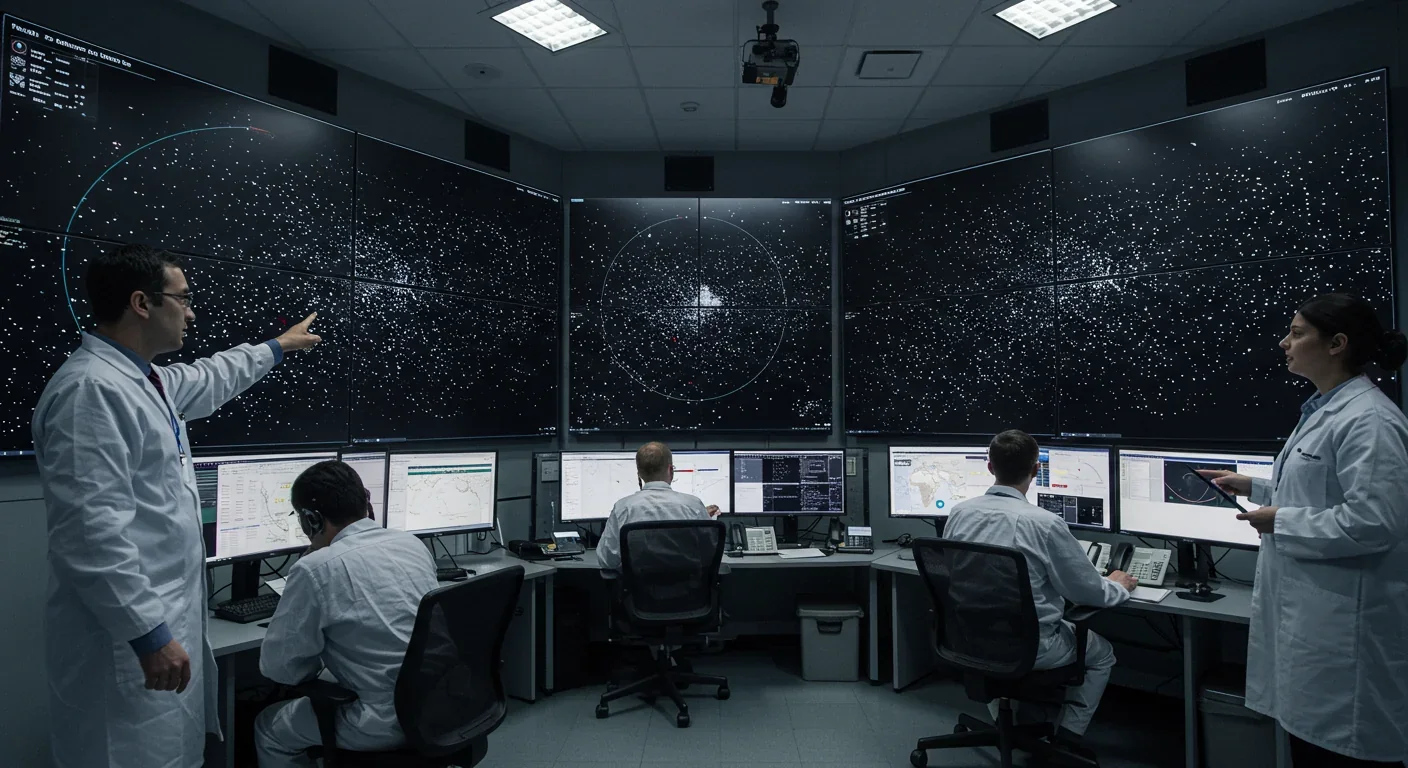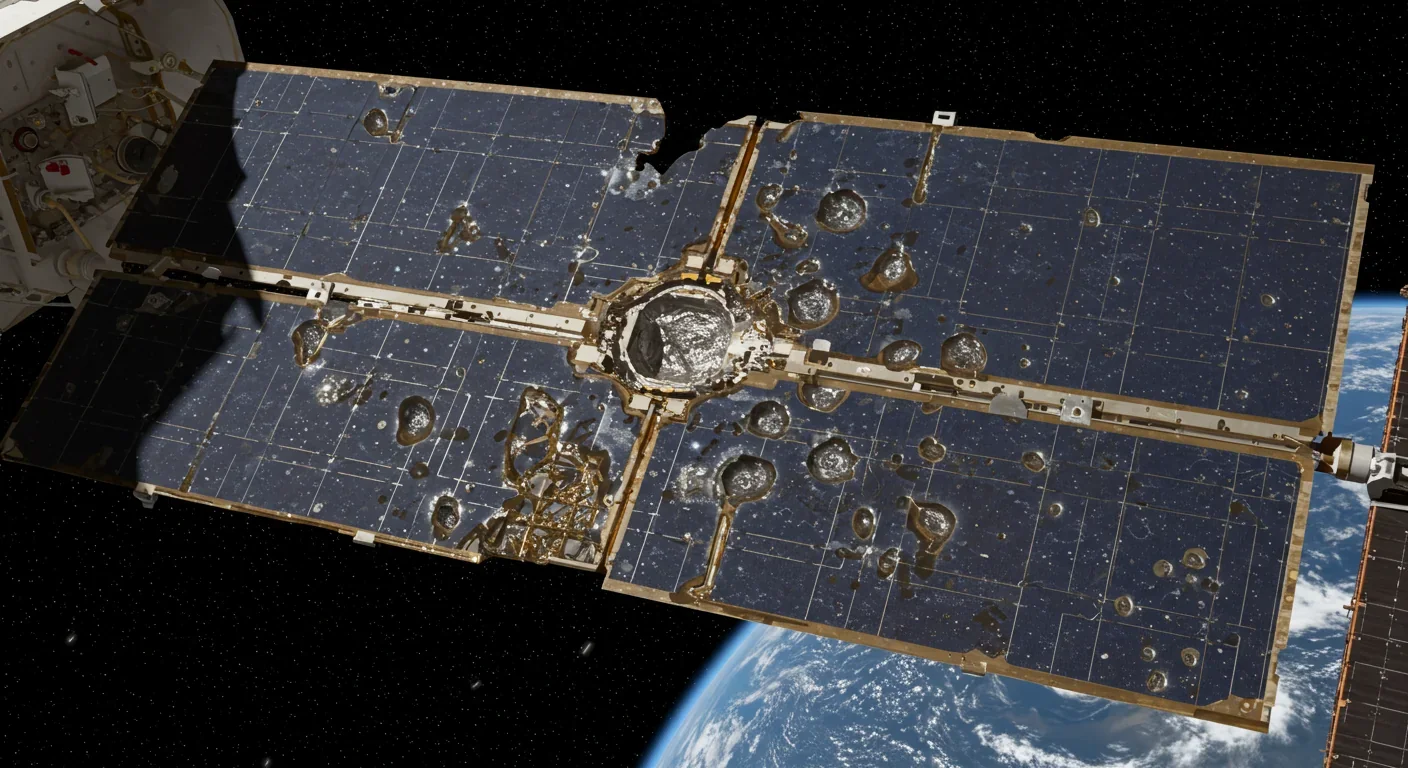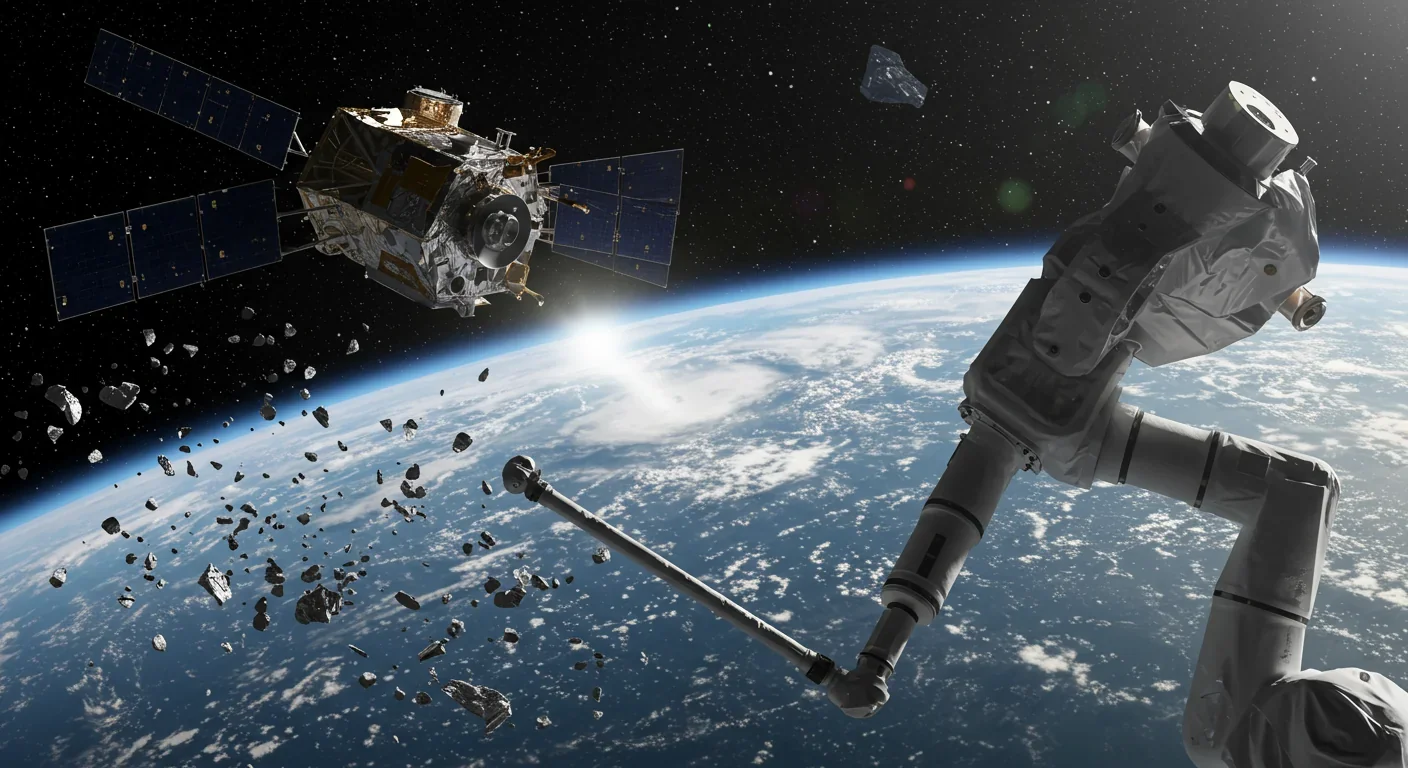Fusion Rockets Could Reach 10% Light Speed: The Breakthrough

TL;DR: Space debris threatens humanity's access to orbit as megaconstellations flood LEO with thousands of satellites. Active removal, orbital refueling, and international cooperation offer solutions, but action is urgent before collision cascades make space unusable.

Imagine standing in Times Square during New Year's Eve, except every person around you is moving at 17,000 miles per hour. Now imagine they're not people but metal fragments, dead satellites, and paint flecks smaller than your fingernail. Welcome to low Earth orbit in 2025.
Since Sputnik's launch in 1957, we've turned the space around our planet into humanity's largest junkyard. More than 30,000 tracked objects larger than a softball currently orbit Earth, alongside millions of smaller fragments too tiny to monitor. Each piece travels at velocities that turn even a paint chip into a bullet. The 2009 collision between Iridium 33 and Cosmos 2251 satellites generated thousands of new fragments in an instant, a stark reminder that space is getting dangerously crowded.
What started as a theoretical concern has become an existential threat to our satellite-dependent civilization. GPS navigation, weather forecasting, global communications, climate monitoring—all rely on satellites threading through an increasingly lethal obstacle course. The question isn't whether we'll face a catastrophic collision cascade, but whether we'll act before it's too late.
Back in 1978, NASA scientist Donald Kessler predicted something terrifying: once orbital debris reaches a critical density, collisions would become self-sustaining. Each crash creates more fragments, which cause more collisions, which create even more debris. The cascade accelerates until entire orbital shells become unusable for centuries.
We're racing toward that threshold faster than Kessler imagined. Approximately 6,960 launches since Sputnik have placed about 22,310 satellites in orbit, resulting in more than 650 break-ups, explosions, or collisions over six decades. The debris density hasn't distributed evenly, though. Low Earth orbit between 700 and 1,000 kilometers has become particularly congested, a sweet spot where atmospheric drag barely exists and debris can persist for centuries.
The math gets scary quickly. Above 800-900 kilometers altitude, natural decay through atmospheric friction becomes negligible. Fragments at these heights will outlive our grandchildren, creating a permanent hazard layer. Models show that even if we stopped launching satellites tomorrow, collisions between existing debris would continue generating new fragments, potentially triggering the cascade Kessler predicted.
The 2009 Iridium-Cosmos collision wasn't just bad luck. It was a preview. Two intact satellites, each the size of a small car, smashed together at orbital velocities and exploded into more than 4,000 trackable fragments. Thousands more pieces too small to track joined the cloud. Every one of those fragments now threatens every satellite in similar orbits.
Here's what makes space debris uniquely dangerous: velocity. Objects in low Earth orbit travel at roughly 7.8 kilometers per second—about 17,500 miles per hour. At those speeds, kinetic energy transforms ordinary materials into devastating projectiles. A fleck of paint carries the impact force of a bowling ball dropped from a skyscraper. A bolt or screw becomes a bullet. A defunct satellite becomes a bomb waiting to detonate.
Tiny fragments revolve around Earth at speeds greater than 17,000 miles per hour; even small fragments may blast through spacecraft walls, cripple necessary systems, and shorten mission lifetimes. The International Space Station regularly performs collision avoidance maneuvers, burning precious fuel to dodge debris. Satellites equipped with tracking data can sometimes move, but most small satellites lack the propulsion for evasive action.
The threat isn't hypothetical. In 2016, a tiny paint chip cracked a window on the ISS. In 2021, a Russian anti-satellite test deliberately destroyed one of their own satellites, creating more than 1,500 trackable fragments and thousands more too small to monitor. The astronauts aboard the ISS had to shelter in place for hours, uncertain whether debris would puncture their modules.
Most satellites today are designed for relatively short operational lifespans—typically 4 to 8 years for LEO satellites, perhaps 15 years for those in geostationary orbit. Once their propellant runs out, they become uncontrollable debris, drifting through high-traffic zones for decades or centuries. International guidelines suggest satellites should deorbit within 25 years of mission end, but compliance remains voluntary and inconsistent.

If the debris problem sounds dire, consider this: we're about to make it exponentially worse. The commercial space boom has ushered in an era of megaconstellations—vast networks of small satellites providing global internet coverage. SpaceX's Starlink alone has deployed over 7,600 satellites as of May 2025, with plans for tens of thousands more. China's Spacesail constellation has launched approximately 90 satellites weighing 14,000 kilograms each since August 2024. Amazon's Project Kuiper plans to launch 578 satellites for its first phase.
These aren't your grandfather's satellites. Previous generations launched a handful of large, expensive spacecraft built to last decades. Modern constellations consist of thousands of relatively cheap, standardized satellites designed for short lifespans. The P-POD standard, first demonstrated in 2003, has become a universal plug-and-play interface for deploying CubeSats as secondary payloads, drastically reducing integration costs.
Economic forces drive this transformation. Reusable rockets and rideshare missions have reduced single-satellite launch costs by over 80%. SpaceX's transporter rideshare missions routinely launch hundreds of small satellites in a single flight, democratizing access to space. This economic revolution delivers real benefits—global broadband, improved Earth observation, enhanced GPS accuracy. But it also floods orbit with hardware operating on razor-thin safety margins.
The rapid proliferation creates a paradox. While these tiny satellites lower costs for end users, their high orbital velocity turns even micrometeoroid-sized debris into high-impact threats. The sheer number of satellites increases collision probability exponentially. Many experts view the deployment of mega-constellations as a significant step toward making Kessler Syndrome a tangible risk.
Megaconstellation operators know the risks. SpaceX has committed to deorbiting Starlink satellites within five years of mission end, far exceeding the 25-year guideline. But intentions mean little if deorbit systems fail. Estimates suggest 7-8% of satellites equipped with deorbit systems will fail to execute properly, becoming long-term debris. At scale, that's hundreds of dead satellites added to orbit every year.
The good news? We're not helpless. Engineers and entrepreneurs worldwide are developing technologies to clean up the mess we've made. Active debris removal—physically capturing and deorbiting defunct satellites and large fragments—has moved from science fiction to operational reality.
Astroscale, a Japanese company, has led this charge. Their ELSA-d mission, launched in March 2021, was the world's first commercial mission to prove core technologies for on-orbit satellite servicing in low Earth orbit. The spacecraft successfully demonstrated rendezvous, proximity operations, and capture techniques using magnetic docking plates. In 2024, Astroscale's ADRAS-J mission completed a 15-meter approach to a derelict H-2A upper stage, showcasing autonomous navigation around tumbling debris.
These demonstrations prove the concept works, but scaling remains challenging. Astroscale expects to charge approximately $8 million to $13 million per satellite for deorbit services. That's viable for high-value assets but economically daunting for mass removal. The company has partnered with JAXA for the Commercial Removal of Debris Demonstration (CRD2) project, targeting data acquisition on an upper stage Japanese rocket body by end of fiscal year 2022.
Europe is betting on ClearSpace-1, a Swiss EPFL spin-off building autonomous in-orbit servicing and active debris removal spacecraft. As prime contractor for ESA's ClearSpace-1 mission, the company will perform the first capture and deorbit of a derelict object using a four-arm robotic mechanism guided by AI-based vision and flash-LiDAR. The mission strengthens European space sovereignty while protecting critical satellite assets.
Different approaches target different debris types. Robotic arms can grab intact satellites. Nets can snare tumbling fragments. Harpoons can spear uncooperative targets. Some concepts even propose using lasers to vaporize surface material, creating thrust that nudges debris into decay orbits. Each technology has tradeoffs in cost, complexity, and risk.
Perhaps the most elegant solution isn't removing debris but preventing its creation. On-orbit refueling could revolutionize how we think about satellite lifespans. Instead of building spacecraft to last 5-8 years and then become garbage, we could service them indefinitely, like gas stations in space.
The technology isn't theoretical. In 2009, the US Air Force and United Launch Alliance demonstrated transferring 12,000 pounds of liquid oxygen and liquid hydrogen between a modified Centaur upper stage and a cargo vehicle. The test proved that large-scale propellant transfer works in orbit. NASA studies dating back to the 1960s laid the groundwork, and SpaceX plans intervehicular propellant transfer demonstrations in 2026 as part of the Artemis Human Landing System.
Commercial ventures are racing to operationalize orbital refueling. Orbit Fab is building "gas stations in space," planning to deploy refueling depots that satellites can visit for propellant top-ups. Arkisys' "The Port" commercial space platforms are collaborating with Orbit Fab to offer integrated servicing facilities. These efforts aim to shift spacecraft from single-use disposables to multi-use assets.
The implications extend beyond debris mitigation. Satellites that can refuel can reposition themselves, adjusting orbits to serve new markets or avoid congested zones. They can maintain precise stationkeeping longer, improving service quality. They become investments worth protecting rather than throwaway commodities.
Rodrigo Schmitt, a PhD candidate at Purdue University studying orbital mechanics, argues that "satellite refueling is the only way to extend the lives of satellites", preventing them from exhausting propellant and becoming passive debris objects. The economic case strengthens as launch costs fall and satellite constellations scale up. Why throw away a functional satellite when you can refuel it for a fraction of replacement cost?

The Inter-Agency Space Debris Coordination Committee (IADC) and the United Nations Committee on the Peaceful Uses of Outer Space (COPUOS) have developed guidelines requiring spacecraft operators to deorbit within 25 years or relocate to graveyard orbits. These recommendations lack teeth. Nations and companies can ignore them without consequence. Compliance rates vary wildly.
The fundamental challenge is that space operates as a commons—shared by all, owned by none. Economists call this the tragedy of the commons: when resources are free to use but costly to protect, individual actors optimize for personal gain while collective costs mount. Every satellite operator benefits from clean orbits but faces costs and technical challenges in disposing of their own hardware. The incentive structure pushes toward minimal compliance.
Some progress is emerging. The US Federal Communications Commission now requires satellite operators to prove they can deorbit within five years as a condition for market access. The European Union is developing space traffic management regulations tied to launch licensing. Japan's partnership with Astroscale on CRD2 demonstrates government investment in commercial debris removal capabilities.
But national initiatives can't solve a global problem. Debris created by one country threatens satellites from all nations. A collision in orbit doesn't respect borders. We need binding international agreements with verification mechanisms and consequences for non-compliance. The parallel to climate change is obvious—delayed collective action on a shared problem with long-term existential stakes.
You can't manage what you can't measure. Improving space situational awareness—knowing exactly what's orbiting where—is crucial for collision avoidance and debris tracking. Currently, the US Space Surveillance Network tracks objects larger than 10 centimeters in LEO and 1 meter in geostationary orbit. That leaves millions of smaller fragments invisible to current sensors.
New detection technologies are emerging. The Southwest Research Institute recently developed a space debris sensor that can detect impact events, determining location, velocity, and even composition during full-scale tests and 3D simulations. Data from these sensors could be shared with satellite operators in similar orbital paths, warning others about high debris activity and creating a collaborative safety net.
Commercial companies are entering the tracking business too. LeoLabs operates a network of ground-based radars specifically designed to track small satellites and debris. They're mapping LEO with unprecedented resolution, providing collision warnings to operators days in advance. More data enables better decisions, but only if operators act on warnings.
Orbital congestion demands robust data sharing and international cooperation. Space traffic management systems need real-time feeds from multiple sources—ground-based radars, space-based sensors, operator telemetry—integrated into predictive collision models. When systems flag a potential conjunction, operators must coordinate avoidance maneuvers, ensuring they don't accidentally make things worse.
Behind the engineering and policy debates lies a deeper question: what do we owe future generations? The decisions we make about orbital debris today will constrain possibilities for centuries.
Every satellite we launch without adequate end-of-life planning is a gift to our descendants—but not the good kind. It's more like leaving toxic waste for them to clean up, except this waste travels at 17,000 miles per hour and could make entire orbital shells inaccessible.
The Kessler Syndrome mirrors ecological tipping points on Earth, where incremental changes trigger sudden dramatic shifts in ecosystem function. Cross the threshold and the damage becomes irreversible within human timescales. Debris at certain altitudes will orbit for millennia. We could lock our grandchildren out of space through negligence today.
The narrative of space debris is not only a technical hurdle but a societal one, requiring a shift from individual gain to collective stewardship of the orbital commons. Like fisheries, forests, and the atmosphere, space demands management balancing current use with long-term sustainability.
This isn't abstract philosophy. Young engineers entering the space industry today will spend their careers dealing with debris we're creating now. Students studying aerospace engineering will design missions constrained by orbital congestion. Children growing up in 2025 may see access to space significantly restricted because we failed to act when we still could.
The space debris crisis sits at an inflection point. We have the technology to mitigate the problem—active removal systems, orbital refueling, improved tracking, design-for-demise satellites. We understand the policy frameworks needed—binding international agreements, enforcement mechanisms, economic incentives for responsible behavior. What's missing is collective will and coordinated action.
The commercial space boom simultaneously exacerbates the crisis and funds potential solutions. Companies like Astroscale and ClearSpace are building debris removal capabilities, but only if there's a viable business model. Megaconstellation operators are improving satellite design and deorbit reliability, but only under regulatory pressure. Market forces alone won't solve a tragedy of the commons; they need governance structures to channel profit-seeking behavior toward sustainable outcomes.
Within the next decade, decisions made in corporate boardrooms and government ministries will determine whether space remains accessible or becomes a hazard zone. The International Space Station, continuous human presence in orbit since 2000, performs collision avoidance maneuvers with increasing frequency. Future space stations, lunar missions, and Mars expeditions will face even greater risks if debris density continues rising.
The stakes extend beyond exploration. Modern civilization depends on satellites for GPS navigation, weather forecasting, telecommunications, financial transactions, military operations, disaster response, climate monitoring, and agricultural management. Lose access to key orbital shells and society faces disruptions cascading through interconnected systems.
Perhaps most importantly, space debris represents humanity's first large-scale environmental problem entirely of our own making in an environment beyond Earth. How we handle it reveals whether we've learned from terrestrial mistakes or will repeat them across the solar system. It's a test case for whether we can govern shared resources sustainably when consequences stretch across generations.
The orbital junkyard isn't inevitable. With technology, policy, investment, and international cooperation, we can clean up the mess and establish practices ensuring space remains accessible. But the window is closing. Every month we delay, thousands more objects enter orbit. Every year we wait, collision risks compound.
The choice facing us isn't complicated: act now or watch helplessly as we turn humanity's greatest frontier into the world's most expensive landfill. Future generations won't forgive us for the latter.

Recent breakthroughs in fusion technology—including 351,000-gauss magnetic fields, AI-driven plasma diagnostics, and net energy gain at the National Ignition Facility—are transforming fusion propulsion from science fiction to engineering frontier. Scientists now have a realistic pathway to accelerate spacecraft to 10% of light speed, enabling a 43-year journey to Alpha Centauri. While challenges remain in miniaturization, neutron management, and sustained operation, the physics barriers have ...

Epigenetic clocks measure DNA methylation patterns to calculate biological age, which predicts disease risk up to 30 years before symptoms appear. Landmark studies show that accelerated epigenetic aging forecasts cardiovascular disease, diabetes, and neurodegeneration with remarkable accuracy. Lifestyle interventions—Mediterranean diet, structured exercise, quality sleep, stress management—can measurably reverse biological aging, reducing epigenetic age by 1-2 years within months. Commercial ...

Data centers consumed 415 terawatt-hours of electricity in 2024 and will nearly double that by 2030, driven by AI's insatiable energy appetite. Despite tech giants' renewable pledges, actual emissions are up to 662% higher than reported due to accounting loopholes. A digital pollution tax—similar to Europe's carbon border tariff—could finally force the industry to invest in efficiency technologies like liquid cooling, waste heat recovery, and time-matched renewable power, transforming volunta...

Humans are hardwired to see invisible agents—gods, ghosts, conspiracies—thanks to the Hyperactive Agency Detection Device (HADD), an evolutionary survival mechanism that favored false alarms over fatal misses. This cognitive bias, rooted in brain regions like the temporoparietal junction and medial prefrontal cortex, generates religious beliefs, animistic worldviews, and conspiracy theories across all cultures. Understanding HADD doesn't eliminate belief, but it helps us recognize when our pa...

The bombardier beetle has perfected a chemical defense system that human engineers are still trying to replicate: a two-chamber micro-combustion engine that mixes hydroquinone and hydrogen peroxide to create explosive 100°C sprays at up to 500 pulses per second, aimed with 270-degree precision. This tiny insect's biochemical marvel is inspiring revolutionary technologies in aerospace propulsion, pharmaceutical delivery, and fire suppression. By 2030, beetle-inspired systems could position sat...

The U.S. faces a catastrophic care worker shortage driven by poverty-level wages, overwhelming burnout, and systemic undervaluation. With 99% of nursing homes hiring and 9.7 million openings projected by 2034, the crisis threatens patient safety, family stability, and economic productivity. Evidence-based solutions—wage reforms, streamlined training, technology integration, and policy enforcement—exist and work, but require sustained political will and cultural recognition that caregiving is ...

Every major AI model was trained on copyrighted text scraped without permission, triggering billion-dollar lawsuits and forcing a reckoning between innovation and creator rights. The future depends on finding balance between transformative AI development and fair compensation for the people whose work fuels it.